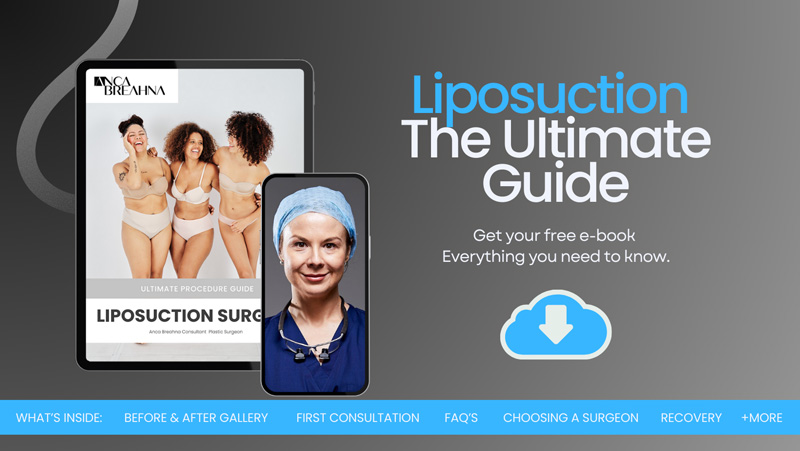
A Guide to Body Contouring After Menopause
Menopause, a natural biological process, brings forth a host of physical changes that may leave you feeling less than comfortable in your own skin. But fear not, for there are numerous solutions available to help you rediscover your inner and outer radiance. In this blog, Consultant Plastic Surgeon Anca Breahna will discuss the various body contouring options, both surgical and non-surgical, that can help you achieve the silhouette you desire.
Download the Liposuction Guide

Common Body Changes during Menopause
As you enter this new chapter of your life, it is important to be well-informed about the common physical changes associated with menopause. Understanding these changes will help you make informed decisions about your health and well-being during this period. Menopause is a natural biological process that marks the end of a woman’s reproductive years, typically occurring between the ages of 45 and 55. During this time, the body undergoes significant hormonal shifts, which can lead to a variety of physical and emotional symptoms.
One of the most notable changes during menopause is the decline in oestrogen levels. Oestrogen, a primary female sex hormone, plays a vital role in maintaining bone density, regulating metabolism, and preserving skin elasticity. As oestrogen levels decrease, you may experience a range of physical changes that can impact your body composition and overall appearance.
One common concern among post-menopausal women is the redistribution of body fat. With the hormonal fluctuations, you may notice that fat begins to accumulate more readily in the abdominal area, leading to what is often referred to as the “menopausal belly” or “menopause pouch.” This shift in body fat distribution can be frustrating and can impact your self-image, especially if you have previously maintained a slim and toned midsection.
In addition to changes in body composition, menopause can also affect the quality and appearance of your skin. As oestrogen levels decline, the production of collagen and elastin, two essential proteins that give skin its firmness and elasticity, also decreases. This can result in increased skin laxity, leading to sagging and wrinkles in various areas of the body, such as the face, neck, arms, thighs, and breasts. You may notice that your skin becomes thinner, drier, and less resilient, which can further contribute to the visible signs of ageing.
It is important to emphasise that these physical changes are entirely normal and are experienced by countless women worldwide. Menopause is a natural part of the ageing process, and embracing these changes as a sign of your wisdom and life experience can be an empowering mindset. However, it is also understandable to feel self-conscious or dissatisfied with certain aspects of your appearance during this time.
The good news is that you are not alone in this journey, and there are effective solutions available to address these concerns. In recent years, advancements in aesthetic medicine and plastic surgery have provided women with a wide range of options to reshape and rejuvenate their bodies. From non-invasive treatments like CoolSculpting and radiofrequency therapy to surgical procedures such as tummy tucks, arm lifts, and thigh lifts, there are numerous ways to restore a more youthful and confident appearance.
Next, we will explore the various body contouring options in detail, discussing their benefits, limitations, and what you can expect in terms of results and recovery.
Non-Surgical Body Contouring Options
If you’re seeking a non-invasive approach to body contouring, there are several options available that can help you achieve notable results without the need for surgery. One popular treatment is CoolSculpting, a revolutionary procedure that targets and eliminates stubborn fat cells through controlled cooling. This FDA-approved method is ideal for those who have localised pockets of fat resistant to diet and exercise. During the procedure, a specialised applicator is placed on the targeted area, delivering precise cooling to the fat cells, causing them to crystallise and eventually be eliminated by the body’s natural processes. CoolSculpting is a safe and effective option for post-menopausal women, requiring minimal downtime and offering gradual, natural-looking results.
Another non-surgical option to consider is radiofrequency treatments, such as Thermage or Ultherapy. These treatments harness the power of radiofrequency energy to stimulate collagen production and tighten the skin. By delivering controlled heat to the deeper layers of the skin, radiofrequency treatments can help improve skin laxity, reduce the appearance of wrinkles, and provide an overall lifting effect. While these treatments may not yield as dramatic results as surgical options, they can be an excellent choice for those who prefer a less invasive approach or wish to complement their surgical results.
It’s important to note that non-surgical body contouring options have their limitations. They are best suited for women with mild to moderate skin laxity and localised fat deposits. If you have more significant concerns or desire more significant results, surgical options may be the most appropriate choice.
Surgical Body Contouring Options
For post-menopausal women seeking more dramatic and long-lasting results, surgical body contouring options can be life-changing. One of the most popular procedures is the tummy tuck, also known as abdominoplasty. This surgery addresses the common concerns of a protruding belly, loose skin, and weakened abdominal muscles. During a tummy tuck, excess skin is removed, and the remaining skin is tightened, creating a flatter, more toned abdomen. In some cases, the procedure may also involve the repair of separated abdominal muscles (diastasis recti) to further enhance the results. Recovery from a tummy tuck typically takes several weeks, but the outcomes are well worth the temporary discomfort.
Another area of concern for many post-menopausal women is the upper arms. As skin elasticity diminishes, the upper arms can develop a sagging appearance, often referred to as “bat wings.” An arm lift, or brachioplasty, is a surgical procedure designed to address this issue. During an arm lift, excess skin is removed, and the remaining skin is tightened, resulting in smoother, more defined upper arms. The incision is typically placed along the inside of the arm, where it can be easily concealed. While some scarring is inevitable, most patients find that the improved contour of their arms outweighs any concerns about scarring.
For women who experience sagging and excess skin in the thigh area, a thigh lift can be a transformative solution. This procedure reshapes and tightens the thighs, creating a more toned and youthful appearance. There are several variations of thigh lifts, depending on the specific areas of concern. An inner thigh lift focuses on the inner thighs, while an outer thigh lift addresses the outer thighs and buttocks.
Liposuction is another surgical option that can be highly effective in targeting stubborn fat deposits and improving body contours. This procedure involves the removal of excess fat through small incisions, using a thin, hollow tube called a cannula. Liposuction can be performed on various areas of the body, including the abdomen, hips, thighs, and arms. It’s important to note that liposuction is not a weight loss solution but rather a means of reshaping and contouring the body. Ideal candidates for liposuction are those who are close to their ideal weight and have good skin elasticity.
In some cases, a combination of surgical procedures may be recommended to achieve optimal results. For example, a tummy tuck may be combined with liposuction to address both excess skin and stubborn fat deposits.
Choosing the Right Body Contouring Option
With so many body contouring options available, it can be overwhelming to determine which one is right for you. When choosing a body contouring procedure, there are several key factors to consider.
- First and foremost, it’s essential to have realistic expectations about the results you can achieve. While body contouring can significantly improve your body’s appearance, it’s not a magic solution, and individual results may vary.
- Another factor to consider is the amount of downtime you can realistically accommodate. Non-surgical options typically require minimal downtime, allowing you to resume your normal activities almost immediately. Surgical procedures, on the other hand, may require several weeks of recovery time. It’s important to factor in your work and personal commitments when deciding on a body contouring option.
- Cost is another consideration when choosing a body contouring procedure. Non-surgical options are generally less expensive than surgical ones, but they may require multiple sessions to achieve desired results. Surgical procedures, while more costly upfront, often provide more dramatic and long-lasting outcomes.
FAQs about Body Contouring Options for Post-Menopausal Women
How long do the results of body contouring procedures last?
- The longevity of body contouring results varies depending on the specific procedure and individual factors. Surgical options, such as tummy tucks and arm lifts, typically provide long-lasting results, given that you maintain a stable weight and healthy lifestyle. Non-surgical options, like CoolSculpting and radiofrequency treatments, may require touch-up sessions to maintain optimal results. It’s essential to discuss your expectations and maintenance plan with Anca.
Will I have visible scars after a body contouring surgery?
- Scarring is an inevitable part of any surgical procedure, including body contouring. However, a skilled plastic surgeon will strategically place incisions in less visible areas whenever possible, such as natural folds or creases of the skin. Additionally, proper post-operative care and scar management techniques can help minimise the appearance of scars over time.
How much time off work will I need after a body contouring procedure?
- The amount of time off work required following a body contouring procedure depends on the type of surgery and the physical demands of your job. Non-surgical options typically involve minimal downtime, allowing you to return to work within a day or two. Surgical procedures, such as tummy tucks or thigh lifts, may require 2-4 weeks of recovery time before you can resume your normal work activities.
Are there any risks or complications associated with body contouring procedures?
- As with any medical procedure, body contouring options carry certain risks and potential complications. These may include infection, bleeding, adverse reactions to anaesthesia, delayed healing, or unsatisfactory results. However, working with an experienced plastic surgeon significantly reduces the likelihood of complications.
How can I maintain the results of my body contouring procedure?
- Maintaining a healthy lifestyle is essential for preserving the results of your body contouring procedure. This includes following a balanced diet, staying well-hydrated, and engaging in regular exercise to maintain a stable weight. Additionally, protecting your skin from excessive sun exposure and using high-quality skincare products can help keep your skin looking firm and youthful. Anca may also recommend specific post-operative care instructions and follow-up appointments to monitor your progress and address any concerns that may arise.
Further Reading about Procedures for Post-Menopausal Women
- Read more about What is a Menopause Makeover?
- Read more about Top Cosmetic Surgery Trends for Menopausal Women
- Read more about How to Fix Saggy Breasts – Breast Uplift, Breast Implants or Both
- Read more about Plastic Surgery for Women in UK
- Read more about How to Get Perky Breasts and Upper Pole Fullness
- Read more about 7 Benefits of a Menopause Makeover
Medical References for Body Contouring Options
- Associations between menopause and body image: A systematic review
- Long-term body composition improvement in post-menopausal women following bariatric surgery
- Menopausal Symptoms and Their Management
- Age as a Risk Factor in Abdominoplasty – Oxford Academic


 Ms Anca Breahna, PhD, MSc, FEBOPRAS, FRCS (Plast) is a highly regarded Consultant Plastic Surgeon specialising in the field of Aesthetic and Reconstructive Plastic Surgery. Anca performs a range of
Ms Anca Breahna, PhD, MSc, FEBOPRAS, FRCS (Plast) is a highly regarded Consultant Plastic Surgeon specialising in the field of Aesthetic and Reconstructive Plastic Surgery. Anca performs a range of 